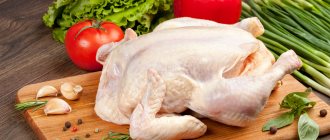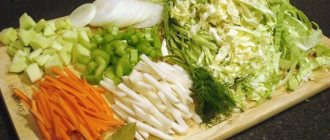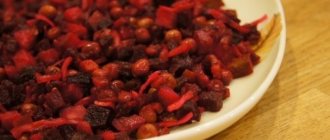Without exaggeration, sauerkraut can be called one of the healthiest foods. Our ancestors could not imagine their table without it and fermented it in large quantities. In addition to many vitamins and microelements, it contains acidic bacteria necessary for the digestive system, which are formed as a result of fermentation. But it is precisely these processes that make many people think that the shelf life of pickled vegetables is very short and such a product is prepared in small quantities. Let's talk about how much and how to store sauerkraut at home.
What factors affect quality and shelf life?
Cabbage variety
A lot depends on the type of cabbage.
Sour cabbage of mid-season and late-ripening varieties is well preserved. It is what ferments for a long time and retains a pleasant crunch and dense texture. Early ripening varieties of cabbage are distinguished by the tenderness of their leaves and are more suitable for preparing salads or light soups, and it is better not to use them for preparations. Such cabbage will resemble boiled cabbage in consistency, and this is unacceptable in this case. Cabbage varieties for pickling or pickling usually have juicy and very dense leaves with thin veins, which can be difficult to chop. The color of such heads of cabbage is very light, almost white. Vegetables with green leaves are in no way suitable for pickling, because such a preparation will most likely taste bitter.
Early ripening varieties are not suitable for fermentation, just like green leaves
Storage containers
You should not store sauerkraut in aluminum containers, as a reaction will begin between the metal and the acid, as a result of which the product will turn black and begin to taste bitter. Eating such a dish will not only be unpleasant, but also dangerous to health. Glass or enamel containers are the most suitable option.
Temperature and humidity
The storage conditions for pickled or sauerkraut are similar in terms of temperature; the ideal is considered to be from +2 ˚C to +5 ˚C. It will not be possible to store cabbage at elevated temperatures: it will quickly turn sour.
You can also freeze the product, if it is not possible to store it in ideal conditions, it is better to do it in portions. In addition, we must remember that repeated freezing will be disastrous for the product. but also very undesirable.
The storage temperature must be constant. It is recommended to store sauerkraut at a fairly high humidity; excessive dryness does not benefit this dish.
Mold protection
Late varieties of cabbage can be stored in pickled form for the longest time - up to six months, especially in the cellar, adding cranberries or lingonberries to the delicacy, which will help prevent the appearance of mold. Mustard and its seeds, as well as sugar, have the same properties if you sprinkle them on the finished product from time to time.
White cabbage is suitable for fermentation, giving better results in taste and storage
Brine quantity
Sauerkraut or pickled cabbage should be stored so that the brine completely covers the shredded leaves. If it becomes insufficient, you need to add the required amount of cool water with the addition of salt into the container with the workpiece. Cabbage fermented in large containers is specially pressed under pressure, because only when in brine will the product retain the incredible amount of vitamin C and other beneficial substances it contains.
How to store sauerkraut
Russians have a special attitude towards sauerkraut. Various dishes are prepared from it, although this is not the main thing. White cabbage is called “Siberian lemon” due to the presence of large amounts of ascorbic acid. It is an indispensable product for preparing vitamin salads in winter, when the flu prevails in the country.
Having fermented cabbage according to your favorite recipes, you need to decide how to preserve the cabbage and what conditions need to be maintained. This concerns the temperature and humidity of the room, protecting products from mold, the use of various preservatives, as well as the choice of containers.
Temperature and humidity
To preserve the beneficial and tasteful qualities of pickled vegetables, you need to take care of the place and certain conditions:
- The ideal storage temperature is considered to be +1 – +5 degrees. At higher rates, the fermentation process continues, albeit slowly, negatively affecting the taste of the pickled vegetable.
- The product is preserved well in the cold, the main thing is not to defrost it twice. Experienced housewives recommend laying out the cabbage in portions.
- As for the air humidity in the room where the sauerkraut is stored, it should be in the range of 85-95%.
Attention! Taking into account the temperature and humidity of the air, pickled white vegetables can be stored for 8-9 months, almost until the new harvest.
Mold protection
Sauerkraut must be protected from the appearance of fungus: a white coating on the surface of the workpiece and in the brine itself. Although not often, this problem occurs when containers are located in a basement or cellar. Mold can be removed, but this will not help preserve the pickled white vegetable. Eating salads is dangerous, it is fraught with allergic reactions or intestinal upset.
There are options to help avoid the appearance of fungus on the workpiece and preserve taste:
- add sour berries such as cranberries and lingonberries;
- Sprinkle the surface of the cabbage with granulated sugar or dry mustard during storage;
- use grated horseradish root for sprinkling;
- Place mustard seeds on the sauerkraut in a canvas bag.
Brine quantity
When storing sauerkraut, you need to make sure that the brine is above the layer of vegetables. Otherwise, the top layer will darken and become unsuitable for consumption. If the chopped leaves are bare, you can dissolve salt in cooled boiled water and add it to the container.
Attention! To prevent the brine from leaving, the pressure returns to its place after the next portion of cabbage has been taken.
Use of preservatives
You can preserve a tasty and healthy snack using preservatives:
- Granulated sugar is sprinkled from time to time on the top of the workpiece.
- Acetic acid helps preserve the product; just a little bit of it is added so as not to spoil the natural taste of cabbage.
- As a preservative when storing sauerkraut, you can use vegetable oil so that it covers the workpiece with a thin film.
- You can add more salt when fermenting, but then cabbage will not be suitable for salads.
How to store carrots in the refrigerator. How to store carrots in a plastic bag all winter
Carrots have firmly entered the daily diet of people living in different countries and continents. This root vegetable is not only tasty, but very healthy. It is used for preparing both first and second courses, as well as for creating desserts and preserves. The vegetable has about 60 species, and its cultivation does not present any particular difficulties, which cannot be said about storing carrots. Rotting or drying of the vegetable with loss of taste and beneficial qualities, alas, often happens with this root vegetable. How to avoid this and whether it is possible to store carrots in plastic bags - let's figure it out together.
Optimal storage conditions for this root vegetable are achieved at temperatures from 0 to + 3 ° C and a relative room humidity of approximately 90%. In addition, the place where carrots are stored should be well ventilated. A basement or cellar will be an excellent storage for a capricious vegetable, the maximum shelf life of which can be up to 12 months.
One of the most convenient, easy-to-install and hygienic ways to store carrots is in the ubiquitous plastic bags. This attribute, without which it is impossible to imagine the life of modern civilization, is widely available and has a low cost. However, storing carrots in plastic bags has its drawbacks. Firstly, this is not the longest possible shelf life for a vegetable. Secondly, frequently monitor the condition of the carrots, dry them from condensation, and replace wet bags with new ones. These measures will help preserve root crops for up to 4 months.
Before storing carrots for storage, they must be dried for 10-14 days, the tops must be cut off so that they do not absorb nutrients, and sorted. Only whole, undamaged, dry and clean vegetables are selected for storage.
It is very important to ensure timely harvesting. If carrots are kept in the soil until frost, gray rot may appear on them.
And if you harvest the crop ahead of time, when the earth has not yet had time to cool, and send the carrots for storage in a cold cellar, then this can also negatively affect the duration of storage of root crops. Many gardeners focus on the condition of the lower carrot leaves: as soon as they turn yellow, it’s time to dig up the crop.
When storing carrots in the cellar, plastic bags of any size are suitable. If there are a lot of root vegetables, then you can use plastic bags that can hold up to 20 kg of vegetables. It is imperative to make a sufficient number of holes on the bags to allow condensation to evaporate, especially at the bottom of the bags, and place them on a stand. There is no need to tie the bags tightly.
You can store carrots in plastic bags not in the cellar, but in the refrigerator, both whole and in chopped form. The latter is stored in the freezer, which significantly increases the shelf life of vegetables. By the way, it is not recommended to store carrots in vacuum bags either in the cellar or in the refrigerator. Root vegetables emit carbon dioxide during storage, which, accumulating in a vacuum, will lead to rapid spoilage of vegetables.
How to prepare grape leaves for dolma for the winter
Grape leaves have long been popular in oriental cuisine, due to their specific pleasant taste and beneficial properties. It has been proven that the consumption of such an ingredient relieves pain from varicose veins, relieves swelling, stimulates blood circulation, and enriches the body with valuable vitamins and microelements.
It is important that during long-term storage the product retains the maximum amount of useful substances in its composition, therefore, of the existing methods, many housewives prefer freezing.
Interesting: When to Collect Currant Leaves for Tea
For these purposes, it is better to choose young specimens of medium size with small veins. It is better to choose the 5th–7th leaf from the top of the vine.
The following foliage is considered unsuitable for cooking:
- from wild (maiden and ornamental) grapes;
- affected by sunburn, mold, fungi and pests;
- with a suspicious yellowish, whitish or cream color;
- old (dangerous due to components harmful to human health);
- growing on a vine near busy roads and industrial production.
Did you know? Dolma has become the source of international controversy: the Azerbaijan National Culinary Center has accused Armenia of “appropriating” the dish, and recently the UNESCO Intergovernmental Committee recognized the traditions of its preparation in Azerbaijan as one of the elements of the intangible cultural heritage of humanity.
Before freezing, it is advisable to prepare the necessary containers. Remember that thin polyethylene and cling film are subject to crumbling under prolonged conditions of low temperatures. In this regard, dense bags are preferred.
Preparing the leaves
To properly freeze grape leaves, you need:
- cut off the ponytails completely;
- thoroughly rinse the workpiece on both sides;
- dry.
Packaging
Dry leaves are stacked on top of each other in 10 pieces and rolled into a roll. In this form, it is packed into bags and sent to the freezer. It is important that there is as little air as possible inside the package. This will protect the product from foreign odors, allow it to cool faster and be better preserved.
Did you know? Dolma was a dish of the court cuisine of the Ottoman Empire.
For proper harvesting, you need to know when to collect and where best to get grape leaves. For dolma, it is preferable to use white grape varieties. Their plate does not have such a jagged edge as the red varieties, and therefore it is easier to wrap minced meat in it. The foliage is collected when the bush is flowering, in late spring or early summer.
Tender leaf blades five through seven are best, if you start counting from the top of the vine. The average size roughly corresponds to the size of the palm: this will be the most convenient way to wrap the filling.
Leaves are cut off before spraying grapes with chemicals. During the summer, you can also carry out pruning, making sure that after treating the plant with fungicides and insecticides, the period specified in the instructions for the drug passes.
Important! Do not eat products from bushes located along highways!
As with any preparation, the quality of the raw materials plays a crucial role, so it is important to understand which leaves can be used for cooking. They should be a uniform green color, without yellowing, spots or signs of pest damage.
There are several ways to prepare food for the winter, the simplest of which is freezing. But the pickled shell has an additional original flavor. Let's consider all possible ways of harvesting grape leaves.
Freezing
Prepared leaves for freezing must be completely dry. Then they do this:
- Place 10–15 leaves and roll them into a tight roll.
- The roll is wrapped in cling film.
- The rolls are placed in a plastic box, since the product will be fragile after freezing.
To prepare dolma, the pieces will need to be defrosted at room temperature or doused with boiling water.
Important! The number of leaves in one roll should correspond to the amount of dolma that is usually prepared at a time.
Bottled storage
This is an original way to keep leaves fresh for a long time. For it you need to prepare empty plastic bottles. The further procedure is as follows:
- Pour a teaspoon of salt and soda into each bottle, add a little water and shake thoroughly so that the mixture covers the entire inner surface. Then the bottle is rinsed with clean water and dried.
- Small stacks of leaves (3–5 pieces) are rolled into tubes and placed very tightly in the bottle, carefully tamping them down with a stick. The bottle must be completely filled. Sometimes a little salt is added at this stage.
- The bottle is pressed down to release all the air and securely closed with a lid.
This container is stored in a dark, cool place for up to 2 years. To prepare, you need to cut the bottle, remove the leaves and fill with cold water. Sometimes a yellowish coating may appear on the surface, which is not a sign of spoilage.
Did you know? In some regions, fig and quince leaves are used to prepare dolma.
Canning
For preservation, it is necessary to properly prepare glass jars and lids. Sterilization of dishes can be done in a pan of boiling water, in a double boiler or slow cooker, in a microwave or oven. Each jar should be treated with hot steam for 20–25 minutes. With this method, the cuttings do not need to be cut; it will be convenient to use them to pull the workpiece out of the jar. Proceed with the prepared leaves as follows:
- The leaves are rolled into a tube and placed tightly in jars, which are then filled with boiling water for 10 minutes. Afterwards, drain the water and fill the jar with boiling water again.
- Add 1 tbsp per liter of water. l. salt and sugar. Bring the mixture to a boil, stirring to dissolve the salt and sugar.
- The water from the cans is drained and filled with a boiling solution.
- The jar is rolled up and gradually cooled.
Interesting: Can Suluguni cheese be frozen?
This product should be stored in a cool and dark place.
Pickling
Containers for pickling are processed in the same way as for canning. Then do this:
- Place 4-5 peppercorns, 1-2 buds of dried cloves, 1-2 bay leaves at the bottom of the jar.
- Rolled leaves are placed tightly on top of the spices and filled with the same solution as for preservation, with the addition of 2 tbsp. l. 9% vinegar.
- The jar is closed and stored in a cool place for up to three months, and dolma can be prepared from such a preparation in just a few days.
Pickling
Salting consists of placing the product in a solution of table salt. To pickle grape leaves, do this:
- The rolled rolls are placed tightly in a clean container and poured with boiling water. After 10 minutes, the water is drained.
- The saline solution is prepared based on the proportion: 20 g of salt per 1 liter of water. Add the required amount of salt to the drained water, bring the solution to a boil and pour it into the jar.
- Cover the container tightly, cool and store in the refrigerator.
Dry storage
For this method, brine filling is not used, but the container must be sterilized beforehand. The sequence of further preparation of the workpiece is as follows:
- Place 10–12 leaves at the bottom of the jar, press down and lightly sprinkle with salt.
- The next layer is compacted tightly and salted again.
- The filled jar is sterilized for 10–15 minutes in the oven or steamed, and then closed with a lid using a special key.
Grape leaves are an integral part of dolma. And although this oriental dish is in many ways reminiscent of cabbage rolls, traditional for Slavic cuisine, they cannot be replaced with white cabbage. In order to enjoy the spicy taste of the dish all year round, you should prepare the future “wrapper” for the rice and meat filling in advance for the winter. Is it possible to freeze it, and how to do it correctly, find out further from the article.
Grape leaves have long been popular in oriental cuisine, due to their specific pleasant taste and beneficial properties. It has been proven that the consumption of such an ingredient relieves pain from varicose veins, relieves swelling, stimulates blood circulation, and enriches the body with valuable vitamins and microelements.
For these purposes, it is better to choose young specimens of medium size with small veins. It is better to choose the 5th–7th leaf from the top of the vine. This wrapper is easy to work with, which is not the case with wrappers that are too small or too large. Leaves should be picked between late spring and mid-June, when they reach their peak growth. Healthy, well-developed specimens of regular shape without damage or signs of disease are preferred.
Oriental dishes have long been part of our lives. For example, dolma, beloved by many. It is very similar to our cabbage rolls. Only for its preparation they use grape leaves instead of cabbage leaves. Fans of this unusual dish for our area may be interested in how to store grape leaves for dolma so that it can be prepared even in winter.
Let's take a closer look at each of them.
The easiest way to store grape leaves for dolma is to sterilize them and roll them into jars.
- In order for them to retain their qualities for a long time, they are collected in 10-15 pieces and rolled into a tight roll.
- Then, the leaves folded in this way are placed in a glass jar and sterilized for 20 - 25 minutes, having previously closed the lid tightly.
- After the jars have cooled, they are rolled up and placed in a dark and dry place.
- The optimal period for collecting grape leaves is the time when the vine begins to flower.
- It is recommended to use leaves of white grape varieties for preservation, since they differ favorably from others in their sweet and sour taste, which will positively affect the taste properties of dolma, giving the dish a wonderful piquancy. If you decide to use red grape leaves for harvesting for the winter, remember that their disadvantage is their uneven surface and hardness.
- Only young leaves are suitable for dolma, and it is important to cut them from the vine, which is located as far as possible from the roadway.
- Never use damaged or torn grape leaves for preservation. Take only smooth, whole leaves, preferably the same size.
- Cooking time: approximately 35-50 minutes.
- Number of blanks: 3 blanks of 20 leaves.
Interesting: Salted saffron milk caps have gone sour, what to do?
What can you do to make cabbage last longer?
You can increase the shelf life of sauerkraut if you add oxidizing berries to it: lingonberries, cranberries, wild berries. With regular addition of sugar, vinegar is gradually formed, which also has a preservative effect.
If there is no balcony, cellar or basement, you can make a preparation for long-term storage in the apartment.
To do this you will need (for 5 kg of product):
- Carrots - 3 pcs.;
- Salt - 90 gr.;
- Sugar - 80 gr.;
- Bay leaf - 5 pcs.
Instead of sugar, you can put honey.
Prepare as follows:
- Peel the carrots and remove the top leaves from the cabbage. Cut out the stalks.
- Grate the carrots and cut the cabbage into strips.
- Place in a large container, mix with spices and press down on top with a plate.
- Use a jar or bucket of water as a press.
- Leave in a warm place for 4 days so that the cabbage begins to ferment.
- The next day, transfer the starter into sterilized jars.
- Leave a distance of 3 cm from the jar lid to the contents empty.
- Place the jars in a large saucepan and fill with water up to the shoulders.
- Sterilize over low heat for about 30 minutes.
- Roll up with a special machine.
This product can be placed in a kitchen cabinet and stored throughout the winter. Take out and use in preparing salads, soups and side dishes.
Sauerkraut can be stored in the refrigerator, freezer and even on the balcony under suitable climatic conditions. In the refrigerator the shelf life is up to 8 months, on the balcony - as long as the air temperature outside the window remains slightly below zero. It is also acceptable to store beets on the balcony.
The optimal storage container is a jar or food-grade plastic container. Ideally, it is better not to freeze cabbage, otherwise it will lose some of its vitamins. When storing it in the freezer for a long time for the winter, it is recommended to package it in portions so that you do not defrost the entire product, but only the part that will be used within a couple of days.
Previous Vegetables and fruitsMethods for storing cranberries at home Next Vegetables and fruitsRules for storing pomegranates at home
How long is the product suitable for consumption?
Temperature is not the only condition that allows you to preserve the original taste and beneficial characteristics of the product for a long time. To increase storage time, the following conditions are required:
- The container in which the cabbage is kept must be opaque and protect the contents from exposure to sunlight.
- Humidity levels in the room where the workpiece is located should be slightly above average, at the level of 85-95%.
The shelf life of a product without noticeable changes in taste and appearance differs depending on where and under what conditions it is stored:
- Refrigerated cabinet - the time during which the cabbage does not spoil depends on how sealed the container is in which it is kept and the temperature (completely sealed and +4 ̊C - shelf life 3 months, container without a lid - 10 days).
- Cellar – the preparation is edible for 3 months, the rest depends on the recipe used.
- A room with a temperature in the range of +6...+10 ̊С – 2-4 weeks.
- In a living room at a temperature of +10 °C, you need to eat the product within 2-3 days.
- On a glazed loggia or balcony at a temperature of 0...+5 ̊С – 4-5 months.
- In the freezer - can last up to 8 months, but subsequent freezing is unacceptable. After thawing, the product must be consumed within 5 days.
Attention! Not only compliance with the humidity and temperature conditions in the room allows you to prolong the freshness, preserve the original appearance, taste characteristics and suitability for consumption of the marinated dish. You can increase its shelf life with the help of a properly selected recipe according to which you plan to marinate.
Choosing the right cabbage for pickling
For this purpose - pickling - only late-ripened varieties of cabbage are suitable. Therefore, the preparation is often done before winter and for a long time, fermenting a large volume of leafy vegetables so that it lasts until spring. Also, late-ripening varieties are chosen because of their increased density, which also increases the taste characteristics of the pickles.
Cabbage, which reaches technical maturity in the summer season, is a good addition to vitamin-rich vegetable salads. But when fermented, it cannot sit for long. Under the influence of table salt, the fibers of cabbage leaves of early and medium varieties soften, lose some of their vitamins, taste and do not crisp. At the same time, not all cabbage heads are suitable for pickling, but only those forks that meet the following characteristics:
- when squeezed, the cabbage head does not deform and retains its elasticity;
- there is no damage on the surface of the cabbage leaves;
- the stalk is light green or cream, without rings or other dark markings;
- The cabbage head does not have limp, rotten or frostbitten leaves.
On a note!
For long-term storage of sauerkraut, you must follow all recommendations. If the forks have been damaged, the pickled vegetable will have a shorter shelf life.
Also, you need to take into account that early or middle varieties can be fermented, but such cabbage will only be tasty for a few days, then it begins to sour
Signs of corruption
You can tell that sauerkraut is gone by the following signs:
- The brine has acquired a thicker, stretchy consistency.
- Uncharacteristically pungent, rotten odor.
- Formation of white mold on the surface.
- Cloudiness of the brine.
- Color change. Typically, lost cabbage darkens and acquires a grayish or greenish tint.
- Bitter taste.
You cannot eat missing sauerkraut. Due to rotting and mold damage, harmful microorganisms develop in it. Eating such a product is fraught with severe poisoning. If the cabbage is lost, it should be disposed of.
Keeping vegetable varieties
Late and late-ripening varieties are well suited for long-term storage:
- Present. The head of cabbage is dense, flat-rounded, light green in color. The variety is resistant to cold, suitable for growing in Siberian conditions.
- Guarantor F1. The head of cabbage has an oval shape, the outside leaves are gray-green, and the cross section is yellow. Excellent taste. Suitable for long-term storage.
- Wintering 1474. The variety is highly resistant to frost. The heads of cabbage are medium-sized, up to 3.5 kg, round-flat in shape. Keeping quality up to 8 months.
- Kolobok F1. A late-ripening variety with dense heads of cabbage, does not crack, the stalk is short. The surface of the head of cabbage is green, in cross section it is white. Highly resistant to disease and rot, excellent shelf life.
- Moscow late. The variety is characterized by high yield and large fruits. Heads of cabbage weighing 8-13 kg, round in shape, green in color. Ideal for fermentation.
How to tell if cabbage has gone bad. What to look for when choosing cabbage?
To understand how to choose the right cabbage, you need to remember the basic rules for purchasing this vegetable.
- Choose heads of cabbage with fresh, unpicked leaves. They should fit tightly to each other and not create the effect of an open fruit.
- Avoid fruits with brown or black areas, even if they are small. This indicates damage by fungi or putrefactive bacteria.
- Inspect the leaves for insect damage, which will show up as grooves or other blemishes on the leaves. Their large number suggests that it is better not to buy such cabbage.
- The head of cabbage must be strong. If when squeezing there is a feeling of softness and airiness, it is better not to choose it, as this indicates staleness or damage to the fruit.
- The leaves should be a rich green color. If they are dull, this does not speak in favor of such heads of cabbage.
- If cabbage has yellow or wilted leaves, it means it is lacking in freshness.
- The heads of cabbage should look clean and smooth, without obvious traces of chemical treatment or signs of frostbite.
- Significant mechanical damage will lead to a rapid loss of vitamin C, so fruits with them should be avoided when choosing.
- If stored improperly, cabbage begins to sprout, which can be seen with the naked eye. Therefore, not only choose smooth, strong heads of cabbage, but also place them in the refrigerator at a temperature of 0 to 4 degrees if you do not plan to use them immediately after purchase.
- The presence of a large number of dry layers in the heads of cabbage (parchment of the inner leaves) is also a defect, due to which the fruits should not be purchased.
Choosing a storage location
It is very important that the temperature in the room where the cabbage is stored does not fall below 0 degrees. A (glazed) loggia can serve as an excellent place to store jars in jars for the winter. If necessary, you can take out the salad in the right quantity, and let the rest remain in its proper place.
Due to constant thawing and freezing, there will be less and less useful microelements and vitamins in cabbage. Therefore, do not allow the workpiece to be either in the house or on the balcony. Use only the amount of cabbage you need and do not return any leftovers to the container.
But most often the salad is stored, of course, in the refrigerator. This is very convenient and you can get the dish at any time without leaving your home. The temperature in it is ideal for storage. The only inconvenience is that it won’t fit a lot of this delicacy, so you’ll have to prepare new portions each time.
Storing cabbage for the winter at home. How to store cabbage at home in winter?
The best cabbage varieties for long-term storage
The following varieties of cabbage have worked well in winter:
- Vyuga variety – eight months.
- Variety Gift – seven months.
- Variety Dombrovskaya – six months.
- Kharkov winter variety – seven months.
- Belorusskaya variety – seven and a half months.
The following varieties also perform well:
- Variety Stone Head – year.
- Amager variety – nine months.
- Variety Snow White – six months.
- Variety Aros and Atria - ten months.
cabbage storage
Places for long-term storage of cabbage
The cabbage harvest should be stored in the following places during the winter:
Basement or cellar. In these places, it is necessary to put the crops on shelves or hang them from the ceiling. If your harvest turned out to be excellent, then you can stack everything, resembling a pyramid, be sure to stack it with the stalks facing up. Before putting cabbage in these places for storage, then it is necessary to put the premises in order so that it is clean, dry and there are no living creatures there. As soon as it starts to get colder, the required temperature is set in such rooms, which helps to avoid losses. In such premises, cabbage is stored for eight months.
Basement
Storage room. Cabbage can be stored in such a room for some time. This method is most suitable for apartments rather than private houses. In a special cool place, cabbage can be preserved longer and better, but the main thing is to pack it in cling film or parchment paper. The forks must not be spread out tightly enough to allow air to circulate. It is in these conditions that cabbage is stored for six months.
pantry
Fridge. Such a crop must be placed in a special freshness zone, where it will be possible to create the necessary temperature for preservation. If you don’t have such a place, then the forks should be put in a section of the refrigerator in which the temperature is quite minimal. Cabbage heads must be packed in film or parchment. In this option, your harvest can be stored for about a month.
Fridge
Balcony. If this room is insulated, then it is necessary to maintain the same temperature all the time; you also need to wrap the crop in paper or film. As soon as it starts to get colder, then the cabbage needs to be put in a closet or wrapped in insulation. The shelf life of cabbage in this case will be five months.
Balcony
Depression in the ground. This storage location is perfect for large cabbage. It is worth understanding that cabbage heads can get damp in such a place and can rot, and when frosts begin, it becomes problematic to get the harvest from there. In this case, you need to dig a trench on a hill, the depth will be half a meter and the width a little more, you need to put straw on the bottom, then lay out cabbage, and then put more straw on top of it, and at the very end, cover everything with a shield of wood. Then be sure to compact the soil on top, its thickness will be approximately 200cm.
Trench
Optimal conditions
The quality of storing cabbage at home depends on the indoor climate. It is imperative to maintain a stable temperature, which is no more than two degrees Celsius, and air humidity should not exceed 95%. There must be ventilation in the room. If you follow these parameters, your harvest can last for eight months.
Harvest storage methods
There are quite a few different ways that help store cabbage harvest, let's look at the different options:
- Box. This option is quite simple, suitable for use in a basement or cellar. In this method, the vegetables are laid evenly without touching each other. Such containers must be installed on small pallets.
- Shelves. Racks with shelves are installed near the wall. Cabbage is laid out directly on them, which is dried in advance, peeled, and then covered with leaves on top. Be sure to lay it so that there are gaps of about two centimeters between the heads of cabbage.
- On paper. In this option, only dried cabbage is stored. You can use newspapers, only clean paper is needed for the first layer. The paper prevents the cabbage from touching, thereby allowing it to be stored for a long time and keep out the cold. The packed cabbage is then placed in boxes or bags.
- Film. This option is the most effective. The prepared cabbage is packaged in cling film and then placed on racks or in a special container. It is imperative to check vegetables during storage so that they do not spoil.
Shelf life of cabbage
- Shelf life: 5 months
- Shelf life: 5 months
- Shelf life in the refrigerator: 1 month
- Freezer life: 12 months
Storage conditions:
Store in a ventilated area or refrigerator at a temperature not exceeding +15 ° C
Before the potato was discovered, cabbage was considered the main vegetable in Europe. It does not belong to overseas vegetables. The past of cabbage is very rich and eventful. This vegetable was even depicted on ancient paintings. Cabbage began its journey from Ancient Greece and then began to spread throughout Europe. Cabbage dishes are present in any national European cuisine. What kind of dishes cannot be prepared using this vegetable. You can list for a long time from cabbage rolls to pies. Cabbage leaves are great for stuffing. And if you chop them, they are perfect for a wide variety of salads. Stewed cabbage is an excellent side dish. To make the dish tasty, you should know the shelf life of cabbage in advance.
We recommend: How long can meat be stored in the refrigerator: folk and generally accepted methods
Cabbage has a long shelf life, so the vitamins it contains can be preserved until the next harvest. Vitamin C is found in cabbage in no less quantity than in citrus fruits. This vegetable also contains an interesting vitamin U, which can be used to treat stomach and duodenal ulcers, colitis, gastritis and intestinal lethargy. Vitamin K ensures good metabolism, heals wounds, helps the liver function and forms healthy teeth and bones. Diabetics and obese people can safely introduce it into their diet, since it contains no starch, little sucrose and is low in calories. With the help of fiber, which is part of cabbage, you can improve your intestinal function. In addition, cholesterol and toxins will leave the body. This will help prevent atherosclerosis. Nutritionists advise eating sauerkraut; they consider it especially healthy. It contains many vitamins and nutrients. The immune system begins to strengthen with biologically active substances.
How many days is cabbage pickled?
Pickling is an ideal way to preserve vegetables. If you follow the right proportions of ingredients, you get a crispy and savory snack. The only negative is the need to keep the vegetable mass warm for a limited period of time.
Only late and mid-ripening varieties are selected for fermentation. They are distinguished by their sweet taste, dense heads and elastic leaves. The fermentation process is greatly simplified due to the presence of sugar in the structure of the vegetable. The Belosnezhka, Podarok, Belorusskaya and Amager varieties are ideal for pickling.
The fermentation time of cabbage is influenced by various factors, which include the amount of salt added. It is advisable to adhere to the correct ratio, so salt by weight of the vegetable mass should be 2-3%. For 10 kg of mixture, 200 g of seasoning is added.
Fermentation begins only at high temperatures. Therefore, properly prepared vegetable mass is left at room temperature, which is 18-22°C. It is impossible to say exactly how long cabbage should be salted before it is ready, so the appetizer is checked periodically, and gases are removed from it by piercing it with a wooden skewer.
Typically, fermentation is carried out over a period of 3 to 5 days. At high temperatures, all vitamins are preserved, and due to the acid content in the vegetable, the appearance of microbes is prevented.
If you know at what temperature to ferment cabbage and how many days you need to keep it in the room, you will get a very tasty and crispy product. The ideal temperature is considered to be 21°C. On about the fifth day, the vegetable mass becomes sourish-winey and pleasant to the taste and is moved to a cold room.
Main problems
Difficulties often arise when preparing pickled vegetables. They are often associated with the fact that people do not know how many days to ferment cabbage at home. They miss the deadline when it is necessary to transfer the workpiece to the cold, and the product turns sour.
Other problems include:
- lack of the required amount of juice, but you can cope with this by adding water;
- if you do not pierce the mass with a skewer, the carbon dioxide will cause the product to become bitter and tasteless;
- using too many carrots causes the vegetable to become soft;
- when the temperature is violated, mucus appears;
- the film occurs at low temperatures;
- lack of salt leads to hard products.
To get a tasty and healthy snack, it is recommended to figure out how many days cabbage is fermented under pressure, which varieties are best to choose and what ingredients to use.
Storage rules
To increase shelf life, it is important to follow a number of recommendations
If you have a refrigerator
This is a great place for a snack. It is recommended to store the sauerkraut in the refrigerator in sealed bags. It is also acceptable to use plastic containers. Such containers can be placed compactly. With these parameters, the product lasts well for 30-45 days.
In an oak barrel
It is best to put this container in a cool place - in the cellar or in the refrigerator. In any case, the temperature should not exceed +2 degrees.
When systematically opening the barrel, a film of mold will appear on the walls and surface of the brine.
It is important to remove it in a timely manner and treat the surfaces with a concentrated salt solution.
In banks
This is a very convenient container for cabbage. It fits easily in the refrigerator. To get a quality product, it is recommended to wash the dishes well with hot water and then sterilize them. This will help get rid of pathogenic microorganisms that can lead to souring of the finished product.
When storing the workpiece in a jar, it is recommended to fill it to the top with brine and then pour in sunflower oil. After this, the container should be closed with plastic lids and placed in a cool place. The product can be stored in this way for 1 month.
In the cellar
This is a great place for sauerkraut. In winter, there is optimal temperature and humidity. It is recommended to keep the workpiece in jars, closing them with metal lids. In summer, storing cabbage for a long time is not recommended, since even in deep cellars the temperature parameters reach +7 degrees.
Choosing a container
In order for the workpiece to be stored for a long time, it is not enough to maintain the correct temperature . It is also important to choose the right container.
Plastic containers
Proper plastic containers must meet safety standards and be intended for storing and freezing food products.
Melamine containers are not suitable for storing workpieces - they are usually not marked and are very toxic. PP, or PP, marking is applied to the safest plastic. It is used to make bottles for feeding children and containers for storing food.
PS, or PS, is also suitable for containers, but such containers should not be heated.
Containers with markings are completely suitable for storing workpieces:
- PET, PETE, or PET;
- HDPE, or HDPE;
- OTHER, or Other.
It is strictly forbidden to use containers marked V or PVC or PVC . This is technical toxic plastic. You should not freeze the product in boxes marked LDPE, or MDV.
Which cabbage is better to choose?
Cabbage is fermented in almost every home, regardless of whether you have your own garden or buy vegetables at the market. But not any cabbage is suitable for pickling. In order not to be disappointed with the result of your labor and the taste of the final product, you should carefully choose a vegetable. Medium and late ripening varieties that have sufficient dry matter and denser leaf mass are suitable for pickling and pickling. Early varieties do not meet these criteria and are not suitable for pickling.
The heads of cabbage should be large in size, dense, not loose (the tighter the forks, the whiter and more tender the leaves inside), white in cross section (this indicates the presence of more sugar, which affects the fermentation process during fermentation), the taste of the head of cabbage is when fresh it should be sweet and crunchy. The stalk should also be elastic and juicy. When choosing cabbage in late autumn, you need to make sure that it is not frostbitten.
Mid-season varieties for pickling:
- Slava - ripens in 113–119 days, fruit - up to 5 kg;
- Gift - ripens in 120–135 days, fruit - up to 5 kg, with a spicy-spicy sourness;
- Anniversary F1 - ripens in 90–95 days, fruit – 2.5–4 kg;
- Dobrovodskaya - ripening on the 110th day, fruit - 10-11 kg, wonderful taste;
- Belorussian - ripens in 120-130 days, fruit - 3-4 kg, it is better to ferment immediately after harvest.
Late varieties for pickling:
- Turkis - ripens in 150-165 days, it is better to ferment closer to winter, fruit - 3-4 kg;
- Geneva F1 - should be fermented at the end of winter or early spring, fruit - 3-4 kg;
- Amager - harvested after 150-175 days, fruit - 2.4-4 kg, taste bitter in autumn, improves with time;
- Snow White, - ripening period - 145-160 days, fruit - 2.5-3.9 kg.
Hybrid varieties are also popular when choosing for pickling; variety selection is aimed at obtaining larger heads of cabbage:
- Moscow late-15 - ripens in 115-140 days, fruit - 10-18 kg;
- Kolobok - ripening in 150 days, fruit - over 5 kg;
- Menza F1 - ripens in 110–115 days, fruit – 5–9 kg;
You can also ferment red cabbage. It has coarser fiber and a bitter taste.
Useful tips
Sauerkraut is a valuable and healthy product. With its help you can diversify your family's winter diet. But for this you need to preserve the white vegetable.
Useful tips to help you do this:
- The preparation is stored well if heads of late-ripening and late varieties of cabbage, which were caught by the first frost, were used for fermentation. This preparation contains a lot of starch and sugar, so the vegetable turns out richly tasty and crispy.
- Features of the premises. The places where sauerkraut is stored should be cool and dark. It should be remembered that the sun's rays destroy vitamins and the vegetable darkens.
- In containers that are stored at a temperature of +1 - +5 degrees, there should always be brine above the chopped vegetables. Otherwise, the top layer of cabbage will become unusable and will have to be thrown away.
- Preparing containers. It is clear that any utensils must be clean and sterile. How to prepare jars for storing vegetables has already been said. If you use pots or barrels, you can resort to grandma's method. Sprigs of honeysuckle or dill are placed in a pre-washed container and filled with boiling water. The grandmothers still heated the stones and threw them into the barrel.
- Cover the top with a lid. Both dill and honeysuckle destroy pathogenic microflora. In such a container, sauerkraut is stored perfectly and does not become moldy.
- Selecting a container for fermentation. When using enamel cookware, you should be aware that chips and cracks not only shorten shelf life, but also negatively affect the quality of the product.
- Aluminum pans are not suitable for fermentation, as they oxidize. As a result, stored products become life-threatening.
- Plastic containers. You need to choose containers designed for storing food. When plastic comes into contact with acid, it can release harmful impurities.
Warning! It is better not to eat winter preparations that have been stored in improper conditions, as there is a risk of poisoning.
What to do with cabbage after freezing
After freezing, you should not eat cabbage raw; it must be cooked: boiled in borscht or stewed. The reason is that during long-term storage at low temperatures, the leaves of the vegetable are damaged by ice crystals.
When the cabbage thaws, it will have a rather unpleasant appearance, so you won’t even want to consume it raw. It’s better to immediately throw it into boiling water if you plan to cook cabbage soup, or into a hot frying pan if you want to enjoy stewed cabbage. You cannot refreeze vegetables after defrosting. It will be spoiled and even dangerous for digestion.
If cooked stewed cabbage has been frozen, you need to defrost it in the microwave, and then, when it has reached room temperature, cook it in the oven or in a frying pan.
Can it be frozen?
Sauerkraut is often frozen. At the same time, its shelf life increases significantly. In this state, she is able to “hold out” for more than eight months.
The defrosted product is somewhat inferior in taste, but retains most of its beneficial properties . After thawing, the product must be stored according to standard rules (at low positive temperatures).
The vegetable cannot be re-frozen, since in this case not only a large amount of biologically active substances is lost, but also the organoleptic properties noticeably deteriorate.











